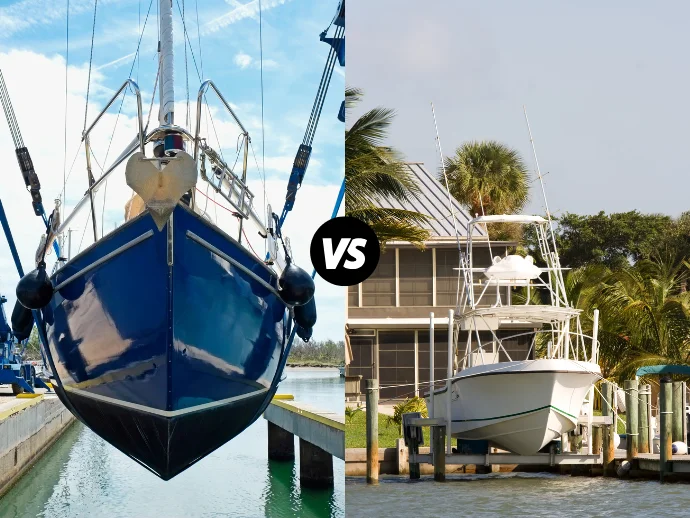
Boat lifts facilitate safer, more efficient launching and storing of your vessel. At the core of this system lies the motor, weighing heavily on your arms every time you raise or lower the boat. But, as with any mechanical part subjected to weather, water, and use, the motor will eventually wear out. It becomes slower, louder with strange noises, or completely shuts down, making it the perfect time for a boat lift motor replacement. Ignoring the signs may lead to costly damages or even leave you stranded on the dock.
In this article, we will go over common symptoms of a dying motor, how to replace it ounce for ounce, and some simple maintenance that will help keep the new one running for the long haul.
Signs You Need Boat Lift Motor Replacement
A boat lift motor does not go from good to bad overnight; rather, it will give you warning signs, and a smart person will heed those signs, thus avoiding costly repairs or a discount on their boat! Check out these common red flags:
● Unusual Noises
Grinding, clanking, or buzzing sounds are typical of a failing motor. These might indicate damage to the internal gears, roller bearings, or even electronic parts.
● Slowed-for-Performance
If the lift took longer than normal to bring something up or down, it might be underpowered or just giving its last breaths.
● Burning Smell or Overheating
If one smells hot or burning, the motor must be overheating. The reasons can be winding failures or insulation failures. Both are serious and need to be attended to immediately.
● Frequent Breaker Trips
If every lift application causes a trip to the breaker, the motor might draw excessively high current. Additionally, it signals a water intrusion or motor short circuit.
● Visual Damage or Corrosion
The motor frame and wiring rust or corrode when exposed to saltwater, rainfall, and moisture, causing cumulative failure.
● Motor Vibrations or Shudders
Occasional vibration or movement indicates that the motor is out of balance or its internals are degrading.
It is imperative that these indicators not be ignored. Therefore, modern boat lift motors are designed for durability, though certainly not free from the ravages of wear and stress imposed by the environment. Early recognition of these signs allows one to take measures before facing a complete failure.
Reasons Your Motor Needs Upgrading
There are good reasons to consider replacing new or old boat lift motors rather than repeatedly patching an obsolete or malfunctioning one.
● Peace of Mind
With a new motor, there will be no chance of breaking down or waiting hours for repairs.
● Safe Working Environment
The new ones are better sealed, more water-resistant, and safer to work on than the old ones.
● Faster and Smoother Operation
A new motor lifts the boat and is noiseless, making docking or launching delightful.
● Modern Features
Most newer versions have wireless remotes, programmable stops, and quiet, direct-drive motors.
● Low Maintenance
Thanks to their better engineering and sealed components, newer motors require fewer maintenance periods and repairs.
Step-By-Step Instructions for Boat Lift Motor Replacement
A daunting task at the onset, but by just using some basic tools and patience, one can go the whole distance in replacing a boat lift motor—a few how-to steps simplified:
1. Choose the Right Motor
Find the right motor for your lift. Depending on your setup, choose between an AC motor and a DC motor, checking voltages, types of drive (belt or direct), and lift capabilities. Always look for a model rated slightly above your boat’s needs for a more secure operation.
2. Gather Your Tools and Cut the Power Supply
Before installation can start, the breaker box’s power must be turned off. A tester must be used to ensure the motor has no voltage. Tools like wrenches, socket sets, screwdriver supplies, and personal protection equipment like gloves and goggles will be provided.
3. Remove the Old Dead Motor
Unscrew any cover above the housing and disconnect the wires; if the motor is screwed to the gearbox frame or mounting, loosen the mounting screws. Be very careful when removing the unit, as it can be dangerous due to corrosion. A couple of gentle hits with a rubber hammer or a little lubricant go a long way.
4. Installing the New Motor
The new motor must be lined up with the drive or gear housing to make a proper fit. Reattach wires by following the wiring diagram (always label wires before disconnection if unsure). Secure the motor to the anti-rust bolts, mounts, or brackets provided. If the motor is belt or friction drive, ensure the drive wheel is in good contact with the pulleys or cable drum.
5. Check Alignment and Drive Engagement
Misalignment will wear out your motor more quickly. Align the motor’s contact wheel so that it is pressed firmly but not too hard against the lift wheel. Make slight adjustments until everything runs smoothly without slippage.
6. Test the Lift Operation
Using the control switch, reenergize the lift and restore electricity. Observe the motor go through a complete lift and lower cycle. Pay attention to abnormal sounds and verify that the limit switches bring the lift to the proper stops. Make adjustments as necessary.
7. Final Inspection and Secure Wiring
Double-verify all electrical connections, nuts, and bolts once everything operates as it should. To protect exposed wires, use marine-grade heat-shrink tubing or waterproof connectors. Fit the motor cover and seal all holes to prevent future water or corrosion intrusion.
Maintenance Tips to Prolong Motor Life
After you finish your boat lift motor replacement, it’s best to adopt regular maintenance habits to safeguard your investment and prolong the motor’s lifespan.
● Regular Lubrication
Lubricate any exposed moving components and bearings with marine-grade grease. This alleviates friction and keeps everything moving well.
● Check for Water Intrusion
Inspect the motor housing periodically for evidence of rust, standing water, or corrosion. Ensure all drain holes are clear, particularly if the motor is installed vertically.
● Inspect Electrical Connections
Check for frayed cords, burned connectors, or rusty terminals. Apply dielectric grease to electrical terminals to shield against moisture and oxidation.
● Run Monthly Tests
Run your boat lift once a month, even in off-season months, to prevent motor parts from seizing. This keeps the inner parts well-lubricated and informs you about any possible problems before the season opens.
● Clean Debris from the Area
Ensure leaves, dust, and animal nests don’t pile up near or within the motor housing. This prevents overheating or electrical obstructions.
When to Replace vs. Repair?
Whether to repair or replace is based on various factors:
- Repair if the problem is isolated, such as a faulty capacitor or small wiring issue, and the motor is under five years old.
- Replace if the motor consistently develops problems, appears to have signs of corrosion, or if repair would exceed 50% of the cost of a new unit.
- Upgrade your lift system if it is over 15–20 years old, particularly if other parts such as cables, cradles, or controls are worn out.
A contemporary motor upgrade can improve your entire docking experience. If you’re already spending money on a new motor, it might also be a good idea to evaluate the condition of the winch, power supply, or control system.
Cost Considerations
A typical boat lift motor replacement will cost anywhere from $300 to $1,200, depending on the voltage, type of drive, and features included in the motor. Installation fees—if properly done—will contribute another $200 to $500. This may seem like a lot of money, but a properly installed motor will survive up to 10–15 years with good maintenance.
You can also purchase motor kits that include remotes, drive wheels, and mounting brackets. These packages are more cost-effective and provide improved compatibility with your current setup.
Final Thoughts
Replacing your boat lift motor is a brilliant and frequently required upgrade that guarantees safety, performance, and peace of mind. By heeding the warning signs of failure, such as unusual noises, slow operation, or circuit problems, you can act before the breakdown spoils your boating day.
Boat lift motor replacement can be a doable DIY project if you have the proper equipment and follow a methodical process. If you combine your new motor with regular maintenance, you will experience smoother lifts, longer system life, and fewer repair headaches.
Ready to Upgrade?
Don’t wait for your boat lift motor to seize completely. If you notice any wear signs, see quality replacement options now. Whether you DIY or hire a pro, a smooth, quiet, and powerful lift system is only one replacement away.
Do you need assistance locating the correct motor? Are you seeking reliable installation services or seasonal maintenance advice? We’re here to guide you every step of the way.



